Related Research Articles

Field Marshal Sir Charles (Carl) August von Alten was a Hanoverian and British soldier who led the famous Light Division during the last two years of the Peninsular War. At the Battle of Waterloo, he commanded a division in the front line, where he was wounded. He later rose to the rank of Field Marshal in the Hanoverian Army.

The Battle of Toulouse was one of the final battles of the Napoleonic Wars, four days after Napoleon's surrender of the French Empire to the nations of the Sixth Coalition. Having pushed the demoralised and disintegrating French Imperial armies out of Spain in a difficult campaign the previous autumn, the Allied British-Portuguese and Spanish army under the Duke of Wellington pursued the war into southern France in the spring of 1814.
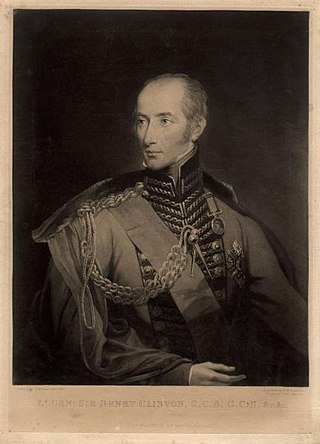
Lieutenant-General Sir Henry Clinton was a British Army officer and a general officer during the Napoleonic Wars.

General Julien Augustin Joseph Mermet fought in the Napoleonic Wars as a division commander in Italy and in the Peninsular War.

The Battle of Orthez saw the Anglo-Spanish-Portuguese Army under Field Marshal Arthur Wellesley, Marquess of Wellington attack an Imperial French army led by Marshal Nicolas Soult in southern France. The outnumbered French repelled several Allied assaults on their right flank, but their center and left flank were overcome and Soult was compelled to retreat. At first the withdrawal was conducted in good order, but it eventually ended in a scramble for safety and many French soldiers became prisoners. The engagement occurred near the end of the Peninsular War.

The 13th Hussars was a cavalry regiment of the British Army established in 1715. It saw service for three centuries including the Napoleonic Wars, the Crimean War and the First World War but then amalgamated with the 18th Royal Hussars, to form the 13th/18th Royal Hussars in 1922.
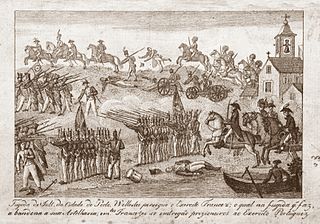
The Second Battle of Porto, also known as the Battle of the Douro or the Crossing of the Douro, was a battle in which General Arthur Wellesley's Anglo-Portuguese Army defeated Marshal Soult's French troops on 12 May 1809 and took back the city of Porto. After taking command of the British troops in Portugal on 22 April, Wellesley immediately advanced on Porto and made a surprise crossing of the Douro River, approaching Porto where its defences were weak. Soult's late attempts to muster a defence were in vain. The French quickly abandoned the city in a disorderly retreat.
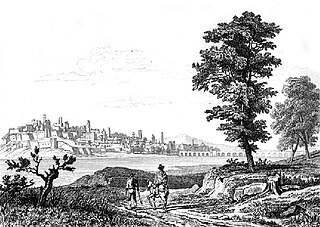
The Battle of the Gebora was a battle of the Peninsular War between Spanish and French armies. It took place on 19 February 1811, northwest of Badajoz, Spain, where an outnumbered French force routed and nearly destroyed the Spanish Army of Extremadura.

At the siege of Burgos, from 19 September to 21 October 1812, the Anglo-Portuguese Army led by General Arthur Wellesley, Marquess of Wellington tried to capture the castle of Burgos from its French garrison under the command of General of Brigade Jean-Louis Dubreton. The French repulsed every attempt to seize the fortress, resulting in Wellington's withdrawal. The siege took place during the Peninsular War, part of the Napoleonic Wars. Burgos is located about 210 kilometres (130 mi) north of Madrid.
This is the order of battle for the Battle of Albuera. The Battle of Albuera was an engagement of the Peninsular War, fought between a mixed British, Spanish, and Portuguese corps and elements of the French Armée du Midi. It took place at the small Spanish village of Albuera, about 12 miles (20 km) south of the frontier fortress-town of Badajoz, Spain. Marshal Sir William Beresford had been given the task of reconstructing the Portuguese army since February 1809. He temporarily took command of General Rowland Hill's corps while Hill was recovering from illness, and was granted overall command of the Allied army at Albuera by the Spanish generals, Joaquín Blake y Joyes and Francisco Castaños.

In the Battle of Maguilla a British cavalry brigade led by Major General John Slade attacked a similar-sized French cavalry brigade commanded by General of Brigade Charles Lallemand. The British dragoons scored an initial success, routing the French dragoons and capturing a number of them. The British troopers recklessly galloped after their foes, losing all order. At length, the French reserve squadron charged into the British, followed by the French main body which rallied. With the tables turned, the French dragoons chased the British until the horses of both sides were too exhausted for the battle to continue. The action took place during the Peninsular War, near Maguilla, Spain, a distance of 17 kilometres (11 mi) northeast of Llerena.
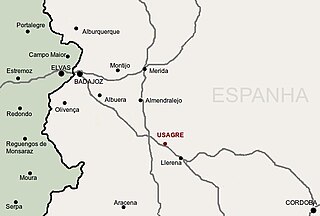
In the Battle of Usagre on 25 May 1811, Anglo-Allied cavalry commanded by Major-General William Lumley routed a French cavalry force led by Major-General Marie Victor Latour-Maubourg at the village of Usagre, Spain, in the Peninsular War.

In the Battle of the Bidasoa on 7 October 1813 the Allied army of Arthur Wellesley, Marquess of Wellington wrested a foothold on French soil from Nicolas Soult's French army. The Allied troops overran the French lines behind the Bidassoa River on the coast and along the Pyrenees crest between the Bidasoa and La Rhune (Larrun). The nearest towns to the fighting are Irun on the lower Bidassoa and Bera on the middle Bidasoa. The battle occurred during the Peninsular War, part of the wider Napoleonic Wars.

The Battle of Bayonne saw the French garrison of Bayonne led by General of Division Pierre Thouvenot launch a sortie against a besieging force of British, Portuguese, and Spanish troops commanded by Lieutenant General John Hope. The fighting marked the last major battle of the Peninsular War and occurred after unofficial news of Napoleon's 4 April abdication reached the opposing forces. Thouvenot's reasons for initiating the sortie are not clear because there was apparently nothing for the French to gain by fighting. After the French enjoyed initial success, Allied forces drove them back inside Bayonne with heavy losses on both sides.
General Sir John "Black Jack" Slade, 1st Baronet, served as a general officer in the British Army during the Peninsular War. Slade was praised in official reports, including by Arthur Wellesley, 1st Duke of Wellington, who also voiced some criticisms of him privately. Slade received an Army Gold Medal, and was honoured three times with the thanks of Parliament. Slade's descendants include two admirals, namely son Sir Adolphus Slade and grandson Sir Edmond Slade. Despite achieving high rank during and after active soldiering, Slade was criticised as a general of cavalry by some contemporaries and historians.
The Battle of Garris or Battle of Saint-Palais saw an Allied force under the direct command of General Arthur Wellesley, Marquess Wellington attack General of Division Jean Harispe's French division. The French defenders were driven back into the town of Saint-Palais in confusion. Because of this minor victory, the Allies were able to secure a crossing over the Bidouze River during this clash from the final stages of the Peninsular War.
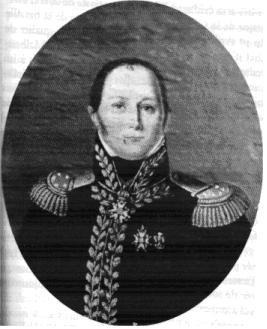
Eloi Charlemagne Taupin became a French soldier before the French Revolution and was killed in 1814 leading his division in battle against the British and the Spanish in southern France. After fighting in the French Revolutionary Wars, he was promoted to command an infantry regiment at the beginning of the First French Empire. He led the unit during the War of the Third Coalition in 1805. The following year he fought in the War of the Fourth Coalition. The year 1808 found him at Zaragoza in Spain where he was wounded. In 1809 he led a brigade during the War of the Fifth Coalition at Gefrees.

The second siege of Badajoz saw an Anglo-Portuguese Army, first led by William Carr Beresford and later commanded by Arthur Wellesley, the Viscount Wellington, besiege a French garrison under Armand Philippon at Badajoz, Spain. After failing to force a surrender, Wellington withdrew his army when the French mounted a successful relief effort by combining the armies of Marshals Nicolas Soult and Auguste Marmont. The action was fought during the Peninsular War, part of the Napoleonic Wars. Badajoz is located 6 kilometres (4 mi) from the Portuguese border on the Guadiana River in western Spain.
This is the order of battle for the Battle of Vitoria.

The Battle of Orthez saw the Anglo-Portuguese Army commanded by Field Marshal Arthur Wellesley, Marquess of Wellington attack an Imperial French army under Marshal Nicolas Jean de Dieu Soult. Soult's army was posted on a ridge to the north of the town of Orthez in southern France and in the town itself. For over two hours the outnumbered French repulsed repeated Allied assaults on their right flank, forcing Wellington to order a general assault. After a struggle, the Allies overcame the French defenses and Soult was compelled to order a retreat. At first, the French divisions withdrew in good order, but as they approached the bridge over the Luy de Béarn at Sault-de-Navailles, many soldiers began to panic. The next day Soult decided that his army was too demoralized to resist more attacks and continued his retreat. Allied casualties were about 2,200 while the French lost about 4,000 killed, wounded and captured. The battle was fought near the end of the Peninsular War.
References
- ↑ Smith, p 519. Note that Smith does not list the regiments suffering no losses.
- ↑ Glover, p 358-359, p 382-387. Units not listed in Smith are inferred from Glover appendices 2 and 5.
- ↑ Hope's Corps (1st and 5th Divisions) was besieging Bayonne.
- ↑ Oman, p 372-373. Oman writes that Fane exercised command over both his own brigade and Clifton's.
- ↑ Lipscombe (2010) has Arentschildt commanding this brigade, and Grüben commandingthe KGL Hussar brigade
- ↑ This figure is the total for artillery across the three Anglo-Portuguese corps
- ↑ The brigade of Morillo's Spanish 1st Division was also part of Freire's 4th Army, but operated under the command of Hill's corp for the battle (Lipscombe, 2010, p.349)
- ↑ The 7th Division had been left in Bordeaux (Glover p. 324)
- ↑ Oman, p 372. Vivian was wounded on 8 April.
- ↑ Smith, p 500-501 and 518-519. For Toulouse, Smith lists the same unit totals as for Orthez. The following totals subtract the losses at Orthez given by Smith.
- ↑ Glover, p 394. To these totals must be added one of Harispe's brigades (Brigade Paris?) which was broken up after Orthez and used to reinforce other units.